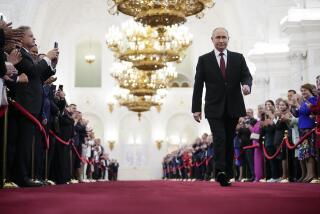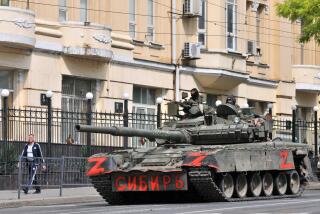REMAKING THE REVOLUTION : SEVENTY YEARS OF SOVIET RULE
- Share via
1917
The Bolsheviks under Vladimir Ilyich Lenin take power in a relatively bloodless coup on Oct. 25 (Nov. 7 by the new calendar), arresting members of the provisional government that had ruled since March and declaring “all power to the soviets, “ or councils of workers. The Bolshevik Revolution triggers a civil war that will continue on and off until 1922 and the formation, in December of that year, of the Union of Soviet Socialist Republics.
1927
The so-called left opposition, consisting of such heroes of the revolution as Leon Trotsky, Lev B. Kamenev and Grigory E. Zinoviev, has been involved in a desperate political struggle with Josef Stalin, who has been trying to consolidate his power since the death of Lenin in 1924. Stalin finally crushes them in December, at the 15th party congress, engineering their expulsion from the party’s ruling bodies. The following year Stalin pushes through the first five-year plan, sounding the death knell of the relatively benign New Economic Policy under which Lenin, in 1921, had abolished the state’s monopoly over small- and medium-scale manufacturing, retail trade and services. The 15th congress also resolved to collectivize Soviet agriculture, setting the stage for the forced collectivization program and subsequent 1932-34 famine in which unknown millions died.
1937
The height of Stalin’s purges, in which millions are tortured, executed or sent to remote labor camps from which many never return. The purge bites deeply into a generation of Soviet leaders. Of 1,966 delegates to the 17th party congress in 1934, only 59 will return for the 18th, in 1939. The carnage strips the army of most of its senior officers at the time of a growing threat from Nazi Germany. Including the victims of forced collectivization, Stalin’s terror is estimated to have cost 20 million lives and to have instilled a fear that continues to handicap Soviet society today.
1947
The country is hard at work rebuilding from the ravages of World War II, in which it suffered 20 million deaths, more than any other country, including Germany. Abroad, Moscow consolidates its hold over the East European countries the Soviet army liberated on its way to Berlin. In September, 1947, Moscow creates the Cominform--the Communist Information Bureau--to coordinate policy among the ruling Communist parties of Eastern Europe. Winston Churchill coins the phrase “Iron Curtain” to describe the barrier thrown up between East and West.
1957
Nikita S. Khrushchev consolidates his power by defeating the so-called anti-party group opposed to his de-Stalinization policy. A year earlier, his “secret speech” to the 20th party congress exposing Stalin’s excesses had stunned the Soviet people, most of whom still thought of the late dictator, who died in 1953, as a near-deity. Khrushchev’s speech also contributed to unrest in Eastern Europe, which climaxed in November, 1956, with Soviet intervention to crush an uprising in Hungary.
1967
Leonid I. Brezhnev, who had ousted Khrushchev as Soviet leader three years before, reigns over celebrations marking the Soviet Union’s 50th anniversary. He emphasizes the need for strengthening the Soviet military, which had been embarrassed by the Cuban missile crisis five years earlier, and for restoring stability within the Soviet Communist Party, which had been shaken by Khrushchev’s erratic personnel policies. As Brezhnev reverses the Khrushchev thaw, he also presides over the elevation of human rights to an international issue. The trial a year before of dissident writers
Andrei Sinyavsky and Yuli Daniel is still regarded as the birth of the Soviet dissident movement. Less than a year after the 50th anniversary celebration, Brezhnev again sends Soviet troops into Eastern Europe, this time to crush the Prague Spring of liberalization in Czechoslovakia.
1977
The detente of the early 1970s withers in the face of Soviet adventurism in Africa and elsewhere and in a clash over human rights, which President Jimmy Carter has made the cornerstone of his foreign policy. At home, an aging Brezhnev rules over an increasingly paralyzed economic and social system, substituting showpieces like the much-ballyhooed but relatively meaningless new constitution for the far-reaching reforms that are so badly needed. Brezhnev assumes the title of president to go along with that of party chief.
1987
Mikhail S. Gorbachev, who took over as Soviet leader in March, 1985, after the deaths in quick succession of Brezhnev, Yuri V. Andropov and Konstantin U. Chernenko, heads toward the 70th anniversary of the Bolshevik Revolution under the twin banners of glasnost and perestroika , preaching the need for the most extensive overhaul of the Soviet system since Stalin’s “revolution from above.”
More to Read
Sign up for Essential California
The most important California stories and recommendations in your inbox every morning.
You may occasionally receive promotional content from the Los Angeles Times.













